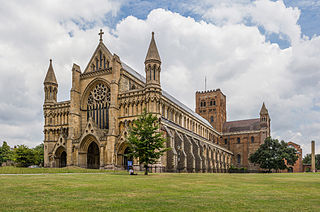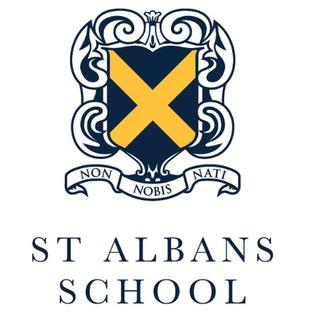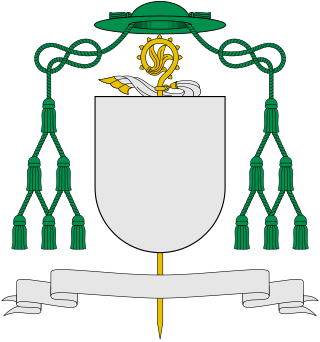Related Research Articles

St Albans Cathedral, officially the Cathedral and Abbey Church of St Alban but often referred to locally as "the Abbey", is a Church of England cathedral in St Albans, England.
Thomas Walsingham was an English chronicler, and is the source of much of the knowledge of the reigns of Richard II, Henry IV, Henry V and the latter reign of Edward III depicting the decline of the state of affairs of the English. He also documented the careers of John Wycliff and Wat Tyler.

St Albans School is a public school in the city of St Albans in Hertfordshire. Entry before Sixth Form is for boys only, but the Sixth Form has been co-educational since 1991. Founded in 948 by Wulsin, St Albans School is not only the oldest school in Hertfordshire but also one of the oldest in the world. The school has been called "Britain's oldest public school" by the Daily Mail. Nicholas Carlisle, in 1818, described the school as "of very ancient origin, and of great celebrity" and the Good Schools Guide describes St Albans as a "traditional public school, with a rich history".

Tegernsee Abbey is a former Benedictine monastery in the town and district of Tegernsee in Bavaria. Both the abbey and the town that grew up around it are named after the Tegernsee, the lake on the shores of which they are located. The name is from the Old High German tegarin seo, meaning great lake.

Richard of Wallingford (1292–1336) was an English mathematician, astronomer, horologist, and cleric who made major contributions to astronomy and horology while serving as abbot of St Albans Abbey in Hertfordshire.
Wallingford Priory was a Benedictine priory dedicated to the Holy Trinity in Wallingford in the English county of Berkshire. Nothing remains of Holy Trinity Priory, which is believed to have stood on the site of the Bullcroft recreation ground off the High Street.

A territorial abbey is a particular church of the Catholic Church comprising defined territory which is not part of a diocese but surrounds an abbey or monastery whose abbot or superior functions as ordinary for all Catholics and parishes in the territory. Such an abbot is called a territorial abbot or abbot nullius diœceseos. A territorial abbot thus differs from an ordinary abbot, who exercises authority only within the monastery's walls or to monks or canons who have taken their vows there. A territorial abbot is equivalent to a diocesan bishop in Catholic canon law.

Saint Paul's Abbey in Lavanttal is a Benedictine monastery established in 1091 near the present-day market town of Sankt Paul im Lavanttal in the Austrian state of Carinthia. The premises centered on the Romanesque monastery church were largely rebuilt in a Baroque style in the 17th century.

The Abbot and then Commendator of Melrose was the head of the monastic community of Melrose Abbey, in Melrose in the Borders region of Scotland. The abbots of the earlier Northumbrian foundation from Lindisfarne are not included here. The second abbey was founded in 1136 on the patronage of David I, King of Scots, by Cistercian monks from Rievaulx Abbey, Yorkshire. Control of the abbey was secularized in the 16th century and after the accession of James Stewart, the abbey was held by commendators. The last commendator, James Douglas of Lochleven, resigned the abbacy to William Douglas, 6th Earl of Morton in December 1606, and the abbey itself to the king in 1608. The abbey was then erected into a secular lordship for viscount Haddington, John Ramsay, who in 1609 was created "Lord Melrose". Lochleven however resumed the title of commendator in 1613 until his death in 1620.
Robert Blackadder was a medieval Scottish cleric, diplomat and politician, who was abbot of Melrose, bishop-elect of Aberdeen and bishop of Glasgow; when the last was elevated to archiepiscopal status in 1492, he became the first ever archbishop of Glasgow. Archbishop Robert Blackadder died on 28 July 1508, while en route to Jerusalem on pilgrimage.
The Abbot of Dundrennan was the head of the Cistercian monastic community of Dundrennan Abbey, Galloway. It was founded by Fergus of Galloway in 1142. Dundrennan was a large and powerful monastery in the context of the south-west. It became secularised and protestantised in the 16th century. In 1606 it was finally turned into a secular lordship in for John Murray of Lochmaben, afterwards earl of Annandale.

St John's Abbey, also called Colchester Abbey, was a Benedictine monastic institution in Colchester, Essex, founded in 1095. It was dissolved in 1539. Most of the abbey buildings were subsequently demolished to construct a large private house on the site, which was itself destroyed in fighting during the 1648 siege of Colchester. The only substantial remnant is the elaborate gatehouse, while the foundations of the abbey church were only rediscovered in 2010.

Martin Marty was a Swiss-born Benedictine missionary and bishop in the United States. His birth name was James Joseph Alois Marty.
Richard of Wallingford, constable of Wallingford Castle and landowner in St Albans, played a key part in the English peasants' revolt of 1381. Though clearly not a peasant, he helped organise Wat Tyler’s campaign, and was involved in presenting the rebels’ petition to Richard II. The petition called for an end to feudal serfdom, the ending of services to a feudal lord, to abolish market monopolies and restrictions on buying and selling goods. Tyler refused to accept a charter offered by the king, despite Richard of Wallingford's encouragement.

Leutfridus was a French monk and saint of the eighth century.

Geoffrey was a 12th-century Anglo-Norman Benedictine monk and abbot. Of Anglo-Norman origin, he became monastic head of the Benedictine priory at Canterbury, before moving to Scotland to be the first Abbot of Dunfermline. As abbot he presided over the construction of the new monastery building, the immigration of English monks and settlers, and the accumulation of enough wealth to make Dunfermline Abbey the richest Benedictine monastic house in the Kingdom of Scotland.
This is a list of abbots of St Albans Abbey up to its Dissolution in 1539.
- Willegod (793–796)
- Eadric
- Wulsig
- Wulnoth (Walworth)
- Eadfrith
- Wulsin
- Aelfric
- Ealdred
- Eadmer
- Leofric
- Ælfric of Abingdon
- Leofstan
- Frithric (Frederic)
- Paul of Caen (1077–1093)
- Richard d'Aubeney (1097–1119)
- Geoffrey of Dunstable (1119–1146)
- Ralph Gubion (1146–1151)
- Robert de Gorron (1151–1166)
- Symon (1167–1183)
- Warin (1183–1195)
- John de Cella (1195–1214)
- William of Trumpington (1214–1235)
- John of Hertford (1235–1263)
- Roger de Norton (1263–1291)
- John of Berkhamsted (1291-1302)
- John de Maryns (1302–1308)
- Hugh of Eversden (1308–1327)
- Richard of Wallingford (1326–1335)
- Michael of Mentmore (1335–1349)
- Thomas de la Mare (1349–1396)
- John de la Moote (1396–1401)
- William Heyworth (1401–1420)
- John of Wheathampstead (1420–1440)
- John Stoke (1440–1451)
- John of Wheathampstead (1451–1465)
- William Albon (1465–1475)
- William of Wallingford (1476–1492)
- Thomas Ramryge (1492–1520)
- Thomas Wolsey (1521-1529/1530), Commendatory abbot
- Robert Catton (1529–1538)
- Richard Boreman alias Stevenage (1538–1539), last abbot
The St Albans Press was the third printing press set up in England, in 1479. It was situated in the Abbey Gateway, St Albans, a part of the Benedictine Monastery of St Albans. The name of the printer is unknown, only referred to by Wynkyn de Worde in a reprinting of one of the St Albans books as 'Sometime schoolmaster'. He has sometimes been identified as John Marchall, master of St Albans School; however, a passage written by Worde in 1497 implies that the printer was deceased, and Marchall is known to have lived until 1501. Recent research has produced the name John Haule as a possible candidate for the Schoolmaster Printer. He presented the school with its first printed textbook, the Elegantiolae, which was the first book printed at the press, and he was a printer, probably in St Albans in 1479.

John of Wallingford was a Benedictine monk at the Abbey of St Albans, who served as the abbey's infirmarer at some time between c.1246-7 and his death in 1258. He is now mostly known through a manuscript containing a miscellaneous collection of material, mostly written up by Wallingford from various works by his contemporary at the abbey Matthew Paris, which survives as British Library Cotton MS Julius D VII. This manuscript includes the so-called Chronica Joannis Wallingford or Chronicle of John of Wallingford.

The recorded abbots of Shrewsbury run from c 1087, four years after Shrewsbury Abbey's foundation, to 1540, its dissolution under Thomas Cromwell. The abbey was large and well-endowed and the abbots were often important political figures as well as ecclesiastical leaders. They varied greatly over the centuries in ethnic and social origins, intellectual attainments and holiness of life. The first two, Fulchred and Godfred, were imported from Normandy. The remainder seem to have been born in Britain and most, but not all, were elected, or at least selected, from the chapter of the abbey. As important territorial magnates, the abbots were always called to take part in the sessions of Parliament from its very beginnings as an institution in 1265. As important figures in the Western Catholic Church, abbots were permitted by the Pope to wear the pontifical ring from 1251 and the mitre from 1397.
References
- ↑ Registra Mon. S. Albani, i. 130
- ↑ ib. i. 5
- ↑ ib. i. 5, 173
- ↑ ib. i. 102–35
- ↑ ib. ii. 22
- ↑ ib. ii. 27, 30, 36, 37
- ↑ ib. ii. 50, 90
- ↑ ib. ii. 109
- ↑ Dugdale, Monasticon, ii. 206 n.
- ↑ ib. ii. 206 n.
- ↑ Peter Newcome, History of the Abbey of St. Albans, p. 398
- ↑ Clutterbuck, p. 35
- ↑ Registra, ii. 219
- ↑ ib. 15 March 1478, ii. 186
- ↑ ib. 20 Aug. 1476, ii. 246, 247
- ↑ ib. 1480, ii. 208, 235
- ↑ ib. ii. 288, 289
- ↑ Registra, ii. 199, 200
- ↑ ib. ii. 267, 268
- ↑ ib. ii. 92
- ↑ Weever, Funerall Mon. p. 556
- ↑ Ames, Typogr. Antiq. ed. Dibdin, vol. i. p. civ
- ↑ Mr. W. Blades's introduction to his Facsimile Reprint of the Boke of St. Albans, London, 1881, pp. 17–18
- ↑ E. Gordon Duff's Early Printed Books, p. 140
![]() This article incorporates text from a publication now in the public domain : "Wallingford, William". Dictionary of National Biography . London: Smith, Elder & Co. 1885–1900.
This article incorporates text from a publication now in the public domain : "Wallingford, William". Dictionary of National Biography . London: Smith, Elder & Co. 1885–1900.